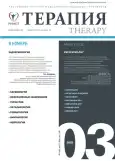Peculiarities of metabolically healthy obesity among the population aged 45–69
- Authors: Berezenko I.L.1, Filippov E.V.1, Volchenkova M.V.1
-
Affiliations:
- Academician I.P. Pavlov Ryazan State Medical University of the Ministry of Healthcare of Russia
- Issue: Vol 11, No 3 (2025)
- Pages: 45-50
- Section: ORIGINAL STUDIES
- Published: 11.06.2025
- URL: https://journals.eco-vector.com/2412-4036/article/view/687160
- DOI: https://doi.org/10.18565/therapy.2025.3.45-50
- ID: 687160
Cite item
Abstract
Obesity is an important medical problem that significantly worsens the prognosis for life and health of the population. However, among obese individuals, there is a group that does not have metabolic complications and is characterized by moderate cardiometabolic risks. This phenotype is called “metabolically healthy obesity” (MHO). Studies of individual obesity phenotypes, MHO in particular, seems to be important in terms of optimizing approaches to the prevention and treatment such kind of patients.
The aim: to study MHO peculiarities among the population aged 45–69 in the Ryazan region.
Material and methods. Analysis included the data from 255 individuals aged 45 to 69 years with no chronic non-communicable diseases. It consisted of 78% female and 22% male patients. NCEP ATP III criteria were used to determine the metabolic health condition. MHO was assessed as a combination of body mass index ≥ 30 kg/m² and less than three criterion indexes.
Results. The prevalence of MHO according to NCEP ATP III criteria among the selected group was 101 individuals (39.6%). From them, 30 were male (53.5% among obese males) and 71 female (35.7% among obese females) individuals. MHO was fixed 1.5 times more often among male persons, p < 0.05. Among MHO individuals, two components of metabolic health disorder were found more common (84.2%) than one (15.8%). No differences were found in the frequency of occurrence of metabolic health disorder components between male and female groups (p> 0.05), as well as in the prevalence of various degrees of obesity (p > 0.05). Differences in the age groups of male and female patients are statistically insignificant (p > 0.05).
Conclusion. The data we obtained indicate a fairly high prevalence of MHO in the population, which promotes interest for a more detailed study of this group of individuals. Detailing MHO phenotype can be useful for risk stratification and personalization of approaches to prophylaxis among obesity patients with.
Full Text
About the authors
Irena L. Berezenko
Academician I.P. Pavlov Ryazan State Medical University of the Ministry of Healthcare of Russia
Author for correspondence.
Email: berezenkoil@yandex.ru
ORCID iD: 0009-0000-6471-7324
MD, assistant at the Department of outpatient therapy, preventive medicine and general medical practice
Russian Federation, RyazanEvgeny V. Filippov
Academician I.P. Pavlov Ryazan State Medical University of the Ministry of Healthcare of Russia
Email: e.philippov@rzgmu.ru
ORCID iD: 0000-0002-7688-7176
SPIN-code: 2809-2781
MD, Dr. Sci. (Medicine), professor, head of the Department of outpatient therapy, preventive medicine and general medical practice
Russian Federation, RyazanMaria V. Volchenkova
Academician I.P. Pavlov Ryazan State Medical University of the Ministry of Healthcare of Russia
Email: mariyasolodun@mail.ru
ORCID iD: 0000-0003-0268-0612
SPIN-code: 2505-9190
MD, PhD (Medicine), associate professor of the Department of outpatient therapy, preventive medicine and general medical practice
Russian Federation, RyazanReferences
- World obesity atlas 2023. URL: https://data.worldobesity.org/publications/?cat=19 (date of access – 28.03.2025).
- Недогода С.В., Верткин А.Л., Наумов А.В., Барыкина И.Н., Саласюк А.С. Ожирение и коморбидная патология в практике поликлинического врача. Часть II: немедикаментозное лечение. Амбулаторный прием. 2016;2(2):44–49. [Nedogoda SV, Vertkin AL, Naumov AV, Barykina IN, Salasyuk AS. Obesity and comorbid pathology in the practice of a polyclinic doctor. Part II: Non-drug treatment. Ambulatornyy priem = Outpatient appointment. 2016; 2(2): 44–49 (In Russ.)]. EDN: WXBOUJ.
- World Health Organization. Obesity and overweight. URL: https://www.who.int/news-room/fact-sheets/detail/obesity-and-overweight (date of access – 28.03.2025).
- Andres R. Effect of obesity on total mortality. Int J Obes. 1980;4(4):381–86. PMID: 6998887.
- Драпкина О.М., Самородская И.В., Старинская М.А., Ким О.Т., Неймарк А.Е. Ожирение: оценка и тактика ведения пациентов. М.: ФГБУ «НМИЦ ТПМ» Минздрава России; ООО «Силицея-Полиграф». 2021; 174 с. [Drapkina OM, Samorodskaya IV, Starinskaya MA, Kim OT, Neimark AE. Obesity: Assessment and management of patients. M.: National Medical Research Center for Therapy and Preventive Medicine of the Ministry of Healthcare of Russia; Silicea-Poligraph. 2021; 174 pp. (In Russ.)]. ISBN: 978-5-9907556-0-4. EDN: IQKSFW.
- Волкова Н.И., Ганенко Л.А., Поркшеян М.И. Метаболически здоровое ожирение – что мы о нем знаем? Медицинский вестник Юга России. 2017;8(3):6–16. [Volkova NI, Ganenko LA, Porksheyan MI. Metabolic healthy obesity, what do we know about it? Meditsinskij vestnik Yuga Rossii = Medical Herald of the South of Russia. 2017;8(3):6–16 (In Russ.)].EDN: ZHRLCH. https://doi.org/10.21886/2219-8075-2017-8-3-6-16
- Smith GI, Mittendorfer B, Klein S. Metabolically healthy obesity: Facts and fantasies. J Clin Invest. 2019;129(10):3978–89. PMID: 31524630. PMCID: PMC6763224. https://doi.org/10.1172/jci129186
- van Vliet-Ostaptchouk JV, Nuotio M-L, Slagter SN, Doiron D, Fischer K, Foco L et al. The prevalence of metabolic syndrome and metabolically healthy obesity in Europe: A collaborative analysis of ten large cohort studies. BMC Endocr Disord. 2014;14:9. PMID: 24484869. PMCID: PMC3923238. https://doi.org/10.1186/1472-6823-14-9
- Бондаренко В.М., Пиманов С.И., Макаренко Е.В., Бондаренко Е.Ф. Метаболически здоровое ожирение: эпидемиология, критерии и патогенетические механизмы. Вестник Витебского государственного медицинского университета. 2023;22(3):19–28. [Bondarenko VM, Pimanov SI, Makarenko EV, Bondarenko EF. Metabolically healthy obesity: Epidemiology, criteria and pathogenetic mechanisms. Vestnik Vitebskogo gosudarstvennogo meditsinskogo universiteta = Bulletin of Vitebsk State Medical University. 2023;22(3):19–28 (In Russ.)].EDN: AWVIAL. https://doi.org/10.22263/2312-4156.2023.3.19
- Мустафина C.В., Щербакова Л.В., Козупеева Д.А., Малютина С.К., Рагино Ю.И., Рымар О.Д. Распространенность метаболически здорового ожирения по данным эпидемиологического обследования выборки 45–69 лет г. Новосибирска. Ожирение и метаболизм. 2018;15(4):31–37. [Mustafina SV, Shcherbakova LV, Kozupeeva DA, Malyutina SK, Ragino YuI, Rymar OD. Тhe prevalence of metabolically healthy obesity: Data from the epidemiological survey in of Novosibirsk. Ozhirenie i metabolizm = Obesity and Metabolism. 2018;15(4):31–37 (In Russ.)].EDN: MZKUUY. https://doi.org/10.14341/omet9615
- Романцова Т.И., Островская Е.В. Метаболически здоровое ожирение: дефиниции, протективные факторы, клиническая значимость. Альманах клинической медицины. 2015;(S1):75–86. [Romantsova TI, Ostrovskaya EV. Metabolically healthy obesity: Definitions, protective factors, clinical relevance. Al’manakh klinicheskoy meditsiny = Almanac of Clinical Medicine. 2015;(S1):75–86 (In Russ.)]. EDN: TPKLCH.
Supplementary files







